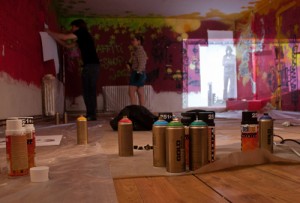
On June 11, ECLA organized a spray paint workshop in which a group of students got together under the leadership of student Josefina Capelle and the professional artist Guillaume Cayrac, whose work can be found throughout Europe, to learn how to create a stencil template and employ useful methods for cutting it out, as well as to try out different spray painting techniques that are used on various backgrounds.
With the newly learned skills, black gloves and a lot of protective plastic sheeting, ECLA students set out to repaint the red walls of the student party room with our own stencils and freehand images. I am happy to report that the final result of our perilous endeavor can only be described in one word, and that word is “awesome.”
But before discussing some of the pieces that are now on the walls of the student party room I would like to first thank our guest, professional street artist Guillaume Cayrac for his great ideas and for sharing with us his genuine love for spray paint art.
“I was commissioned many times to make small, sellable pieces for a big amount of money, but I don’t want to destroy the art,” Mr. Cayrac commented.
Mr. Cayrac’s love for his work was evident to all of us who participated in the workshop. With his enthusiasm, knowledge, and help we were able to transform the student party room into a work of art.
Making spray paint stencils is much easier than what one may think, provided that one has all of the necessary materials. Therefore, with simple instruction, even a rookie stencil artist is able to produce impressive work (as was the case with a number of our party room stencils). Step one of creating a stencil template entails choosing the image that one wants to work on.
Not all images render great stencil pieces so choosing of a suitable image is an important and a necessary first step. For example, images that contain a lot of shading should be avoided by the beginner stencil artist because of their lack of visible contour lines.
The second step requires one to have basic computer skills, primarily photo editing, which is used to emphasize the contrast of the image. A strong contrast is preferable because of the confusion that sometimes arises in step three — the tracing and the cutting process. Once the wanted contrast is reached, the image is projected onto paper and the contour lines of the object that is going to be cut out are traced. The missing or the cut out part will be the image of the final product.
If one is making a stencil of a face, which was the case for all of our stencils, one must be careful to leave little connectors attaching the facial features to the outside of the face so that the features do not fall off. And finally, once cutting is finished, one can proceed with painting.
The stencils that were created during the workshop range from Michel Foucault as a garden gnome to portraits of fellow students. ECLA students who have seen our final products know that I am not exaggerating when I say that the pieces we created this past Saturday couldn’t be distinguished from professional work (mostly because Mr. Cayrac was there to correct our blemishes).
And finally, I couldn’t end this article without mentioning the stencil that a fellow student Catalin Moise and I worked on. Our magnificent stencil is an image of Frank Faber, a restaurant owner/singer whose soul penetrating voice will not be forgotten by any ECLA student who dined at his restaurant during our winter trip to Braunlage. Frank Faber and the time I spent at his restaurant are very symbolic of my experience at ECLA this year.
What Mr. Faber and ECLA have in common is their uniqueness? Both are charismatic, both are unapologetic about their ways (Mr. Faber allows his guests to dance on dining tables and he sports leather pants during his performances), and thanks to Stefan the Chef, both have provided ECLA students with delicious food. It is because of these reasons and many more that I will never forget my year at ECLA and my dinner at Mr. Faber’s restaurant.
by Milan Djurasovic (AY’11, USA)

Great story! Reminds me of my students days in uni.